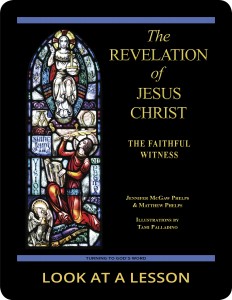manifest / visible
 The ninth chapter of the Gospel According to John (NABRE) contains themes of light and darkness, seeing and blindness, and the interrelationship of those elements. Congenital blindness appears in the readings as a metaphor for the human condition, and Jesus’ healing of the blind man represents the healing he came to offer to us all.
The ninth chapter of the Gospel According to John (NABRE) contains themes of light and darkness, seeing and blindness, and the interrelationship of those elements. Congenital blindness appears in the readings as a metaphor for the human condition, and Jesus’ healing of the blind man represents the healing he came to offer to us all.
In the midst of this exchange is a key question and answer. Jesus’ followers ask him whose sin caused this man to be born blind, and in the Gospel According to John 9:3 (NABRE), Jesus responds: “Neither he nor his parents sinned; it is so that the works of God might be made visible through him.” Some other translations have manifest instead of visible. The Greek word used in this passage, φανερός (phaneros), literally means visible or able to be seen, and that exact connotation is important to the text. This man was created unable to see specifically for the purpose that God could be seen. The significant contrast is important to catch in order to fully understand what the Evangelist John is suggesting.
In our fallen state, humanity normally is unable to see or to grasp God with our senses. One of the core problems in the Fourth Gospel is how we can come to accept God under these circumstances. The answer that Jesus keeps returning to is faith. Faith allows us to perceive and to grasp God outside of our human senses, but it also doesn’t come from nothing. Jesus came to provide someone in whom we can have faith so that we can again perceive God. Jesus, by his very presence, makes visible what was invisible. He is the light of the world.
you also may like our study of the book of Revelation
 The Revelation of Jesus Christ: The Faithful Witness, a 23-lesson Catholic Bible study with an imprimatur, examines ways in which our traditional Christian view of heaven is built on Hebrew apocalyptic visions recorded in the Old Testament. This recently revised study includes maps and additional commentary and takes a close look at the role of the prophets in present-day Christianity. Illustrations by Tami Palladino depict the often-misunderstood images in the book of Revelation. Click on the book’s cover to view a sample lesson.
The Revelation of Jesus Christ: The Faithful Witness, a 23-lesson Catholic Bible study with an imprimatur, examines ways in which our traditional Christian view of heaven is built on Hebrew apocalyptic visions recorded in the Old Testament. This recently revised study includes maps and additional commentary and takes a close look at the role of the prophets in present-day Christianity. Illustrations by Tami Palladino depict the often-misunderstood images in the book of Revelation. Click on the book’s cover to view a sample lesson.
 Click on the picture of the statue of Moses with horns (above) to learn more about Lost in Translation. A new entry is archived each Monday. Contact us to receive Lost in Translation by email every week. You may use any of the contact links on our website to ask Matthew a question.
Click on the picture of the statue of Moses with horns (above) to learn more about Lost in Translation. A new entry is archived each Monday. Contact us to receive Lost in Translation by email every week. You may use any of the contact links on our website to ask Matthew a question.
